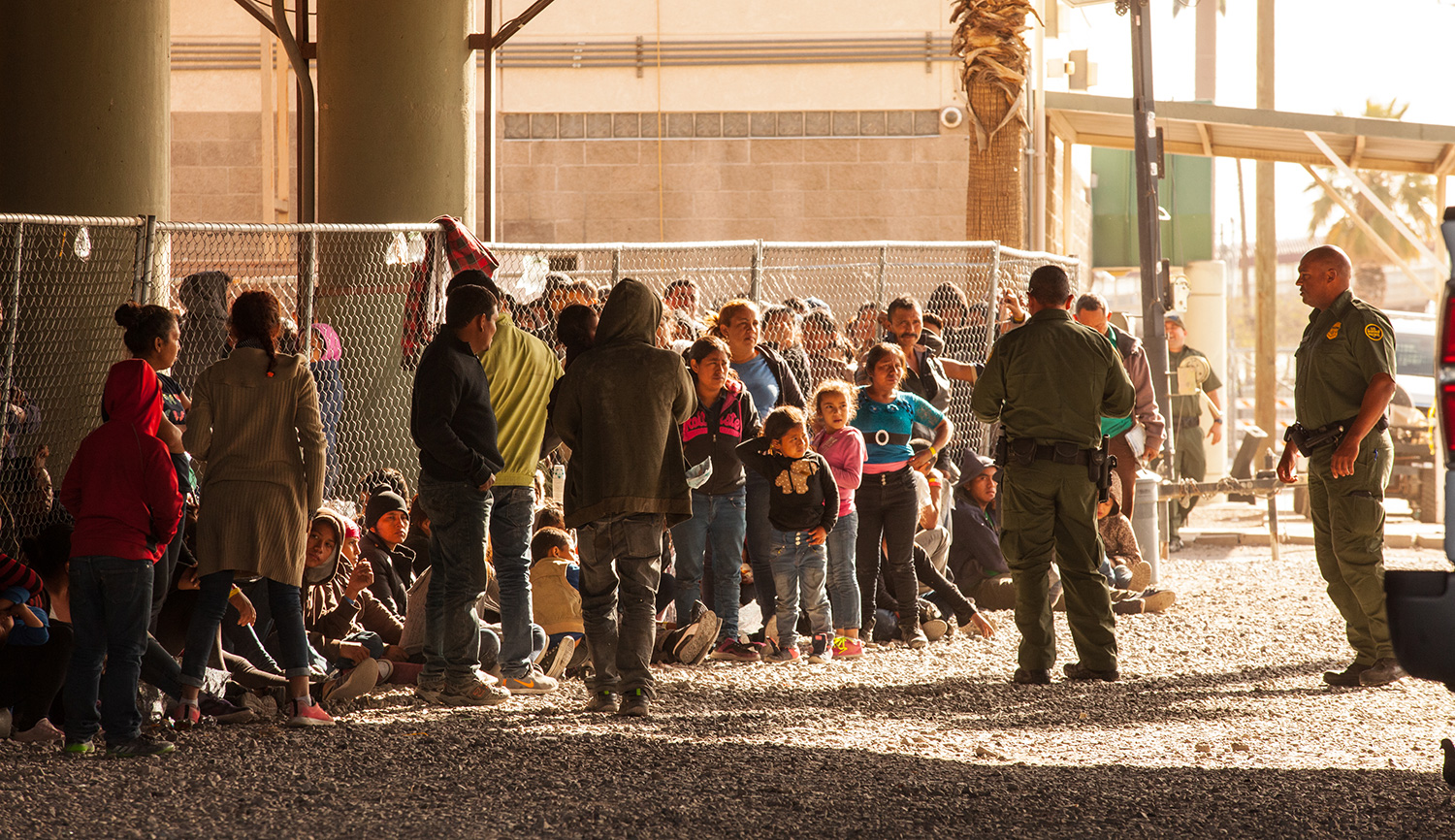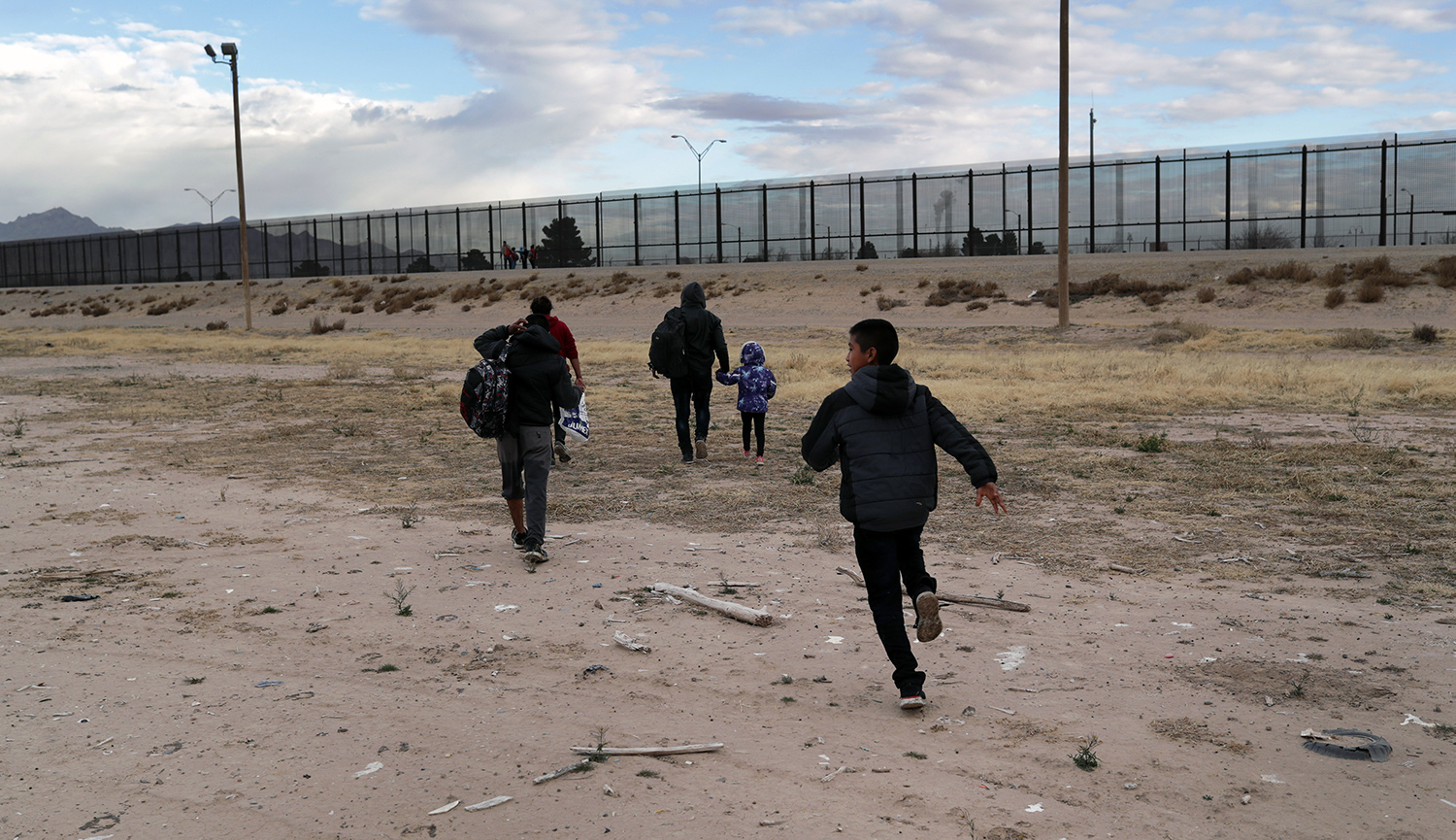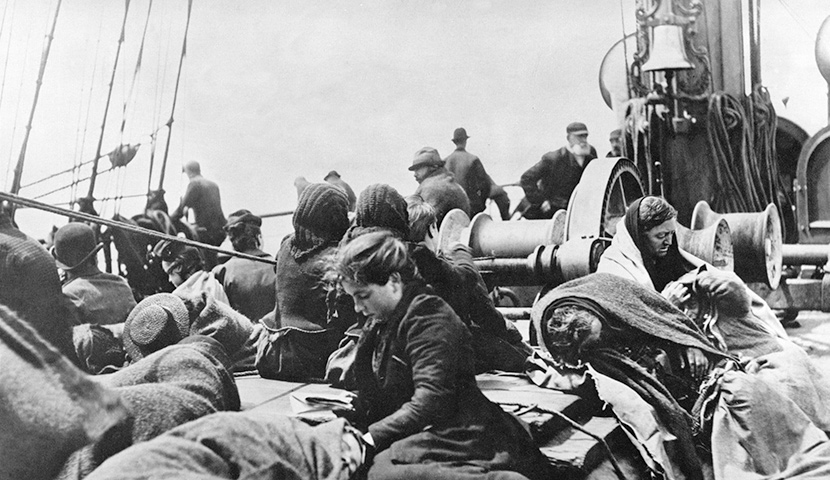I’m grateful to Christopher Caldwell, Linda Chavez, and Daniel Johnson for their thoughtful, and thought-provoking, responses to my essay in Mosaic on America’s immigration woes. Especially heartening is their evidently broad agreement with me that the distinction between migrants and refugees is analytically outmoded and in need of rethinking as a tool of law. I also greatly appreciate the focus on history and the international perspective that the respondents bring to bear.
In what follows I mean to comment on three themes that, in various ways, are addressed by each respondent—and then to point to a motif that, without ever being made explicit, seems to me to lurk behind our joint discussion.
The Jewish Angle
Daniel Johnson very helpfully brings to the table the history of European and particularly English experience with refugees, migrants, and asylum seekers. In so doing, he adduces, as did I, the Jewish case as a tellingly illustrative example. Here he is on certain key 20th-century episodes:
In 1905, as the [British] debate about the desirability of “refugees” revived, a new Aliens Act was passed that required those arriving in the UK to offer proof of identity and the ability to support themselves.
. . . When a new wave of Jewish émigrés, now escaping from Nazi Germany, arrived in the 1930s, the British government was reluctant to recognize their status as refugees. By 1939, just 70,000 had been accepted.
Later, once the full horror of the Holocaust was taken in, those numbers came to be recognized as shamefully low—though they were not dissimilar proportionately to the American record.
Johnson is right: after closing off mass migration, both the UK and the U.S. admitted only a paltry number of Jews as refugees, even after the rise of the Nazis. But America did previously admit multitudes more, and over a much longer time span. By 1924, the year the U.S. restricted mass immigration—nearly two decades later than Britain—more than two million Jews (as opposed to Britain’s approximately 150,000) had arrived, as had tens of millions of non-Jews from regions that would themselves soon lie in the murderous path of Nazism, Communism, and other horrors of mid-20th-century Europe.
Thus, one lesson from that period is the utter importance in principle of keeping our doors open to the world, for we never know whom we may be saving or from what. But to do this, the cause of immigration itself must remain popularly legitimate and sustainable—a task at which America failed in 1924. Today’s Americans who believe we can put, or at least tolerate, unlimited stress on the system rely on a rosy immigration narrative that’s more myth than fact. Backlash has shut the doors before, and could shut them again.
With that prospect in mind, reforms to the present system are desperately needed—not from a nativist or restrictionist perspective but from the perspective of those who want to keep the doors open. And this reinforces another lesson from the early 20th century, one that Americans had to learn at great cost in two world wars: the utter necessity of remaining engaged with the world, not only as a matter of vital relevance to our own national security but because ultimately it is where they live that we can most help those abroad in need of help.
Indeed, it seems to me that underlying much of our present, sentimental inclination to accommodate virtually numberless claims for asylum are pangs of conscience over the effects of American and European withdrawal from the world after the failures of intervention in places like Iraq and of non-intervention in places like Syria. A West more confident of its ability to do good would be more clear-eyed about the dangerous expansion of an asylum regime that cannot possibly be taken to its logical extreme but that nobody seems willing to put a stop to.
In this regard, I agree entirely with Linda Chavez’s call for aid to and cooperation with Central American nations, along the lines followed by the second Bush Administration vis-à-vis Colombia. The same advice applies to any European nation with the capacity to help Middle Easterners and Africans in or near their own homelands.
What, if anything, does the Jewish experience have to do with all of this? To Christopher Caldwell, very little.
Before going further here, I should clarify a possible misunderstanding. In writing that Jews “led” the Great Wave of immigration, I did not mean that they stood out in some way from others, as Caldwell seems to think—hence, his reminder that “Jews were migrants just like everyone else”—but that temporally, as one of the first (and most visible) groups to flee Europe in substantial numbers as early as the 1880s, the Jewish example showed others how it could be done.
More substantively, Caldwell rejects the idea that we can learn “anything special” from the great Jewish migration to the U.S., either because (as above) Jews were just like everyone else or because, somewhat contradictorily, they were so unique as not to yield any generally applicable lessons.
In citing Jewish migratory history, I was in part motivated by my reading of Robert Chazan’s recent scholarly volume, Refugees or Migrants, which sheds much light on the subject. Ever since the Exodus from Egypt, Jews have been, in their own imagination and in that of others, the prototypical refugee people, forcibly exiled from their own land, thereafter persecuted and repeatedly displaced from one temporary refuge to another. If, even for this people, the historical truth is actually more complex than that—as Chazan definitively shows—surely there is reason for us to question whether the putatively hard distinction between migrants and refugees should bear as much weight as law and culture ask it to bear. Happily, on this general point, Caldwell agrees.
As for the proposition that the Jewish experience in America is too unique to extrapolate from, Caldwell contends that, unlike others, Jews “were (or became) highly qualified to contribute to society in every way.” That parenthetical phrase, “or became,” is telling. While Jews were indeed literate at unusually high rates, it was not immediately apparent that this was a more useful skill than, say, having the disposition and the wherewithal to head inland and start a farm on the prairie.
Only later, as the American economy changed, did it become clear just how valuable were the traits that would enable second- and third-generation Jews to move up in the world. As with so much in human affairs, timing and circumstances count for a great deal. In holding that the Jewish “angle” offers lessons for students of immigration, and for policy makers, to contemplate, I take that factor into consideration as well.
Low-Skill vs. High-Skill
In my essay I asserted that “the blue-collar jobs that awaited the first-generation immigrants [of previous eras] and let them build a home no longer exist, and . . . the escalator that once lifted their children from factory floor to executive suite may well be broken.”
This is wrong, Linda Chavez writes:
Work requiring less than a B.A. still accounts for two-thirds of all jobs and will likely continue to do so for at least the next decade. According to estimates by the Bureau of Labor Statistics, even among the 30 fastest-growing occupations, only eighteen will require a college degree or higher, while nine out of ten new jobs will be in the service sector.
But this, too, can be questioned. The issue is not, as Chavez puts it, whether we “still need . . . immigrant workers who don’t necessarily have college degrees”; it’s whether we still need our current proportion of such workers, and our current system for admitting them.
The fact that most American workers are still blue collar, or that some blue-collar jobs are growing quickly, does not mean that the net demand for unskilled immigrants corresponds with the high levels at which immigration numbers are currently set. Under most realistic versions of an alternative, “points” system that would favor the skilled over the unskilled, we would still be admitting hundreds of thousands of unskilled workers annually on grounds of family reunification alone. And this is not to mention the years-long, in some categories decades-long, backlog of cases still waiting to be decided.
Chavez suggests she’d like more blue-collar and more white-collar immigrants. To say the least, however, so massive an increase in legal immigration seems politically unfeasible. Much more imaginable is that the U.S. could maintain its present annual rate (the world’s highest) of about one-million legal immigrants while, through a points system, rejiggering the composition to focus more on skills and less on non-nuclear-family connections. For reasons that Reihan Salam advances in Melting Pot or Civil War?, such a rejiggering is likely to benefit poor and rich, native-born and immigrant alike.
I noted in my essay that such a system would continue to draw from all parts of the world and would not, contrary to what liberal critics allege, function as a subterfuge for a Eurocentric or “whites-only” policy. Caldwell responds:
Have you noticed the rate at which the European population is falling? A promise not to build the American population out of Europeans is like a promise not to build kitchenware out of ivory—the resource required is so rare as to render the project fanciful.
Actually, that European “resource” is nowhere near so rare as Caldwell states: there are still 750 million people in Europe. And as the EU’s passport- and border-free Schengen system shows, European workers at every skill level are happy to move about within its 26-member zone in search of new opportunities. Falling birthrates aren’t going to change these facts. The real answer to critics of a points system, as I wrote in my essay, is that the rest of the world has become vastly more educated—and notably both India and China, the two countries from which much of our immigration is already starting to come. There’s no reason whatsoever for a points system either to proceed from, or be designed to abet, a racially-driven calculus.
Are Immigrants Assimilating?
Even as “dire predictions have accompanied every influx of newcomers throughout our history,” writes Linda Chavez, “assimilation and upward economic and social mobility have been the rule.” Hispanic assimilation in particular, she shows, is proceeding apace, as measured by climbing rates of education, of intermarriage, and of self-identification as American. This is a tribute both to the power of American culture and to the genuine aspirations of immigrants to become at home in that culture—and a rebuke at once to the denials of progress by naysayers and to those America-disparaging elites for whom “assimilation” is almost a dirty word.
And yet: assimilation to what? If lower-blue-collar immigrants are becoming integrated into a lower-blue-collar America that is itself cut off from traditional sources of a stable middle-class identity, and that feels itself to be intensely alienated, can we really say that all is well with mass unskilled immigration? This is Salam’s point: that, for the benefit of both native-born and foreign-born Americans, we must focus on the crippling problems of our lower- and lower-middle class here at home, and that greater high-skill immigration would be more conducive to ameliorating those problems than would continuing the high levels of low-skill immigration.
Asylum Seekers and the Question of Legitimacy
In early March, the Customs and Border Patrol announced that the situation at the southern border had reached a “breaking point” from the pressure of masses of asylum-seekers. In her response to my essay, Linda Chavez gives us the numbers:
In February of this year, the border patrol took into custody more than 76,000 such migrants [seeking asylum], including some 40,000 adults traveling with children and unaccompanied minors—the largest number in over a decade.
The New York Times elaborated: although those surrendering at the border “may not have a good case to remain in the United States permanently, it is not so easy to speedily deport them if they arrive with children and claim protection under the asylum laws” (emphasis added).
This brings me to the background issue that I mentioned early on: namely, the uniquely corrosive effect that the asylum crisis is having on the legitimacy of our immigration procedures, and the extent to which that unresolved crisis may in turn be corroding the larger political legitimacy of the American project itself.
The current influx of asylum seekers at the southern border is equivalent to a 10-percent increase in legal immigration per year—and growing. Moreover, as Chavez points out, there is currently an 800,000-person backlog of applicants waiting for a hearing—about 80 percent of any given year’s quota of legal immigrants. These applicants are not exactly authorized to be here, but also not unauthorized.
The plain fact is that the asylum crisis coopts our laws to semi-legitimize what would otherwise be illegal immigration. Adding to this corrosive effect is the extent to which lawyers, activists, lawmakers, and professors are working to perpetuate a system that lacks any official mandate. No wonder so many people see asylum, to paraphrase Christopher Caldwell on the distinction between migrants and refugees, “not as a description of sociological reality but as a set of legal tricks for keeping the door of immigration open.” (In Europe, as Daniel Johnson notes, those “tricks” have been perpetrated on a much grander and more alarming scale.)
Ever since ancient Athens, the question of who gets to join the demos, the people, has attracted deep, abiding attention. After all, if the people are to be the source of legitimate power, there must be a self-governing consensus on who is part of the people and how one who is not already such a person might become one.
This cannot be dismissed as a matter of nativist prejudice, though it can and does tap into various forms of prejudice, in our time as in ancient Athens. (One of the few surviving legal speeches from that era is Apollodoros’s Against Neaira, which essentially concerns a case of citizenship fraud; the legal argument is also loaded with appeals to misogyny.) But just as the fact that there have been Red Scares does not discredit the need to keep a wary eye on Russia or the critical importance of a sound defense policy, the existence of prejudice does not negate the need for borders, immigration laws, and procedures for obtaining citizenship. To pretend otherwise is sophomoric.
What happens when the state neglects the need for a properly working and properly legitimate immigration system—something that many rightly see as not just a key government responsibility but as one of the pillars of democracy itself? There are policy areas where inaction may be rationally deemed better than action, on the grounds that opening Pandora’s box can be more dangerous than leaving a current system, however imperfect, in place. But immigration is not one of those areas.
If asylum is going to be kept as an option (and I think it should be), it absolutely has to be restricted to cases that truly “shock the conscience.” Otherwise, sooner or later, when the backlash comes, the sound uses of asylum policy will be slashed right along with the new, expanded ones. The current situation is not sustainable; nor is it being sustained.
More about: Immigration, Politics & Current Affairs







